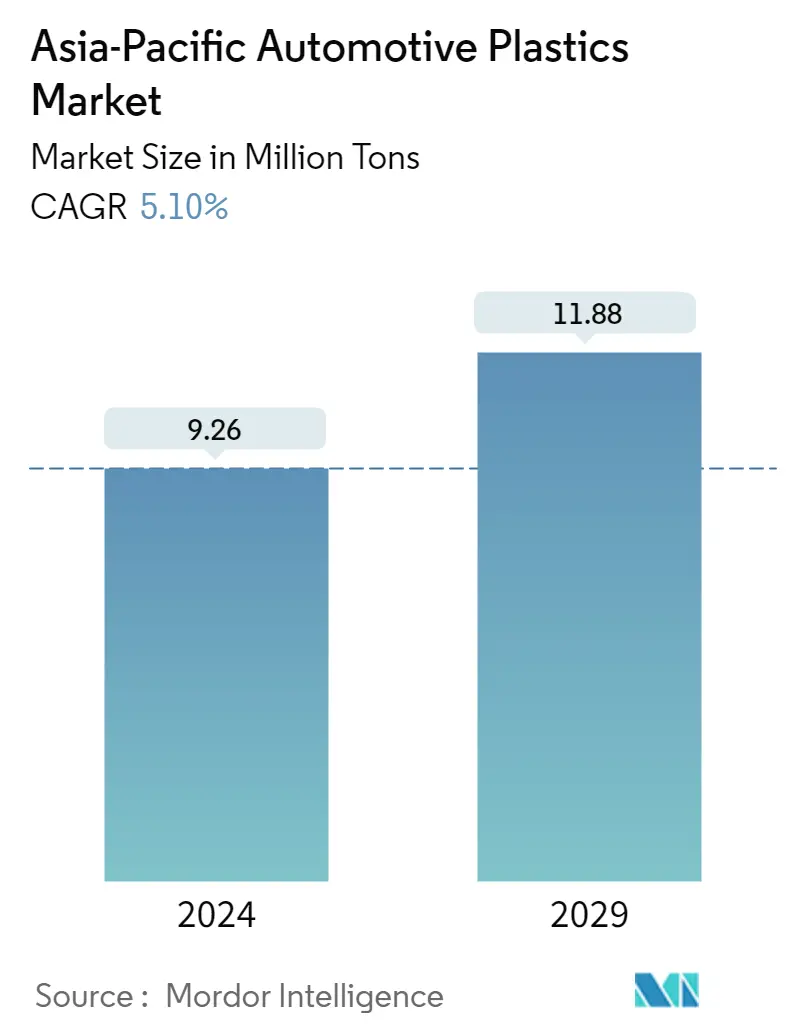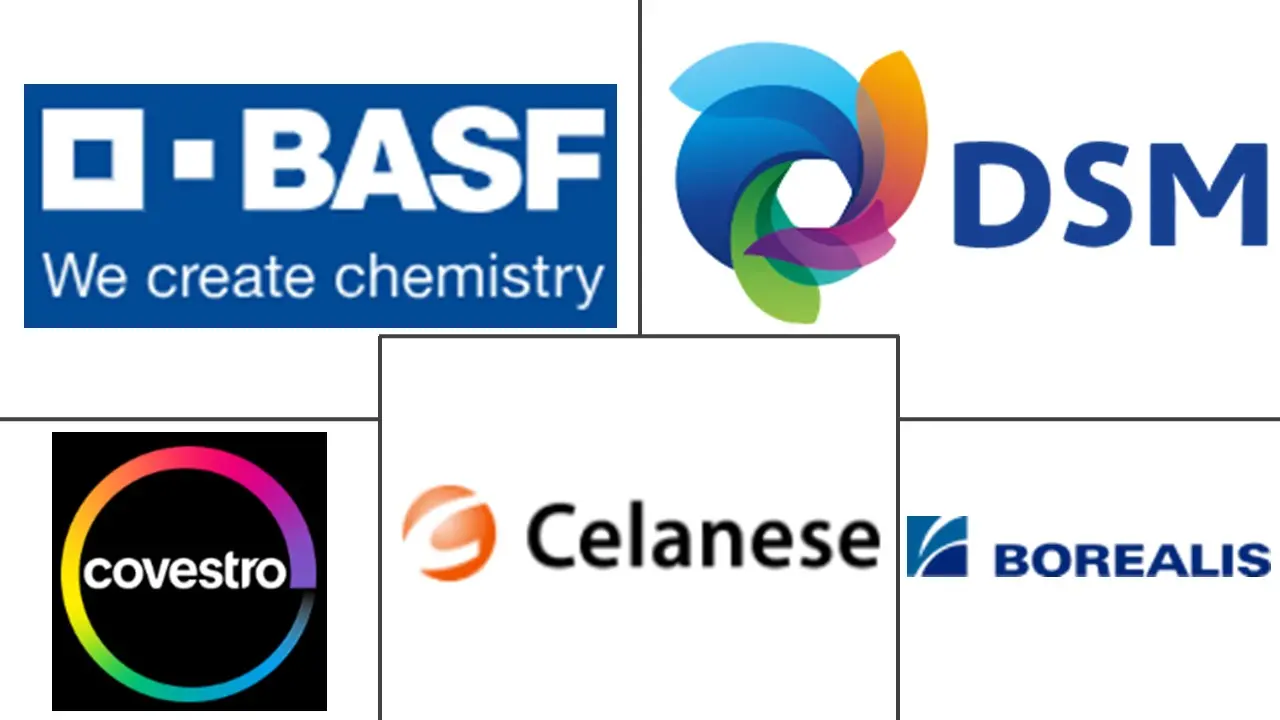Market Size of Asia-Pacific Automotive Plastics Industry

| Study Period | 2019 - 2029 |
| Base Year For Estimation | 2023 |
| Forecast Data Period | 2024 - 2029 |
| Historical Data Period | 2019 - 2022 |
| CAGR (2024 - 2029) | 5.10 % |
| Market Concentration | High |
Major Players
*Disclaimer: Major Players sorted in no particular order |
Asia-Pacific Automotive Plastics Market Analysis
The Asia-Pacific Automotive Plastics Market size is estimated at 9.26 Million tons in 2024, and is expected to reach 11.88 Million tons by 2029, growing at a CAGR of 5.10% during the forecast period (2024-2029).
The COVID-19 pandemic has affected the automotive plastics market negatively. Due to the lockdown and restrictions, the supply of raw materials was disrupted leading to a negative impact on the manufacturing activities in the region. However, the conditions started recovering in 2021, restoring the market's growth trajectory.
- The increasing demand for lightweight materials and increasing polypropylene applications in vehicles are the major factors driving the growth of the market studied.
- However, challenges associated with plastic recycling are likely to restrain the growth of the studied market.
- Nevertheless, an increase in market penetration of electric vehicles is likely to create lucrative growth opportunities for the studied market.
- China represents the largest market over the forecast period due to the increasing demand for electric vehicles.
Asia-Pacific Automotive Plastics Industry Segmentation
Automotive plastics are engineering plastics that have high performance which makes them compatible with the rigorous demands of the automotive industry. Generally, they are versatile, making them suitable for achieving the needed innovation in the industry. The use of engineering plastics in automobiles reduces vehicle weight, which also supports improving the fuel efficiency of the vehicle.
The automotive plastics market is segmented by material, application, vehicle type, and geography. By material, the market is segmented into polypropylene (PP), polyurethane (PU), polyvinyl chloride (PVC), polyethylene (PE), acrylonitrile butadiene styrene (ABS), polyamides (PA), polycarbonate (PC), and other materials (acrylonitrile styrene acrylate (ASA), polyethylene terephthalate (PET), polybutylene terephthalate (PBT), Acrylic (PMMA)). By application, the market is segmented into the interior, exterior, under-bonnet, and other applications (instrument panel, powertrain, door systems, etc.). By vehicle type, the market is segmented into conventional/traditional vehicles and electric vehicles. The report also covers the market size and forecasts for automotive plastics in 5 countries across the Asia-Pacific region. For each segment, the market sizing and forecasts have been done based on volume (tons).
| Material | |
| Polypropylene (PP) | |
| Polyurethane (PU) | |
| Polyvinyl Chloride (PVC) | |
| Polyethylene (PE) | |
| Acrylonitrile Butadiene Styrene (ABS) | |
| Polyamides (PA) | |
| Polycarbonate (PC) | |
| Other Materials (ASA, PET, PBT, PMMA, etc.) |
| Application | |
| Exterior | |
| Interior | |
| Under Bonnet | |
| Other Applications (Instrument Panel, Powertrain, Door Systems, etc.) |
| Vehicle Type | |
| Conventional/Traditional Vehicles | |
| Electric Vehicles |
| Geography | |
| China | |
| India | |
| Japan | |
| South Korea | |
| ASEAN Countries | |
| Rest of Asia-Pacific |
Asia-Pacific Automotive Plastics Market Size Summary
The Asia-Pacific automotive plastics market is poised for significant growth, driven by the increasing demand for lightweight materials and the expanding applications of polypropylene in vehicles. Despite the initial setbacks caused by the COVID-19 pandemic, which disrupted supply chains and manufacturing activities, the market has shown resilience and is on a recovery path. The region's market is further bolstered by the rising penetration of electric vehicles, particularly in China, which is the largest market due to its robust demand for EVs. Plastics play a crucial role in the automotive industry, contributing to vehicle lightweighting, fuel efficiency, and enhanced safety and comfort for passengers. They are extensively used in various vehicle components, from dashboards to engine covers, making them indispensable in modern vehicle manufacturing.
China's dominance in the automotive sector, both in production and sales, significantly influences the demand for automotive plastics in the region. The country's strategic focus on electric vehicles, supported by government subsidies and advancements in battery technology, has positioned it as a global leader in EV sales. This surge in vehicle production and sales, coupled with the increasing adoption of plastics in luxury car interiors by brands like BMW, Audi, and Mercedes, is expected to drive market growth. The Asia-Pacific automotive plastics market is characterized by its consolidated nature, with major players such as BASF SE, Borealis AG, and Covestro AG actively expanding their production capacities to meet the growing demand. These developments underscore the market's potential for continued expansion over the forecast period.
Asia-Pacific Automotive Plastics Market Size - Table of Contents
-
1. MARKET DYNAMICS
-
1.1 Drivers
-
1.1.1 Increasing Demand for Lightweight Materials
-
1.1.2 Increasing Polypropylene Application In Vehicles
-
1.1.3 Other Drivers
-
-
1.2 Restraints
-
1.2.1 Challenges Associated with Plastic Recycling
-
1.2.2 Other Restraints
-
-
1.3 Industry Value Chain Analysis
-
1.4 Porter's Five Forces Analysis
-
1.4.1 Bargaining Power of Suppliers
-
1.4.2 Bargaining Power of Buyers
-
1.4.3 Threat of New Entrants
-
1.4.4 Threat of Substitute Products and Services
-
1.4.5 Degree of Competition
-
-
-
2. MARKET SEGMENTATION (Market Size in Volume)
-
2.1 Material
-
2.1.1 Polypropylene (PP)
-
2.1.2 Polyurethane (PU)
-
2.1.3 Polyvinyl Chloride (PVC)
-
2.1.4 Polyethylene (PE)
-
2.1.5 Acrylonitrile Butadiene Styrene (ABS)
-
2.1.6 Polyamides (PA)
-
2.1.7 Polycarbonate (PC)
-
2.1.8 Other Materials (ASA, PET, PBT, PMMA, etc.)
-
-
2.2 Application
-
2.2.1 Exterior
-
2.2.2 Interior
-
2.2.3 Under Bonnet
-
2.2.4 Other Applications (Instrument Panel, Powertrain, Door Systems, etc.)
-
-
2.3 Vehicle Type
-
2.3.1 Conventional/Traditional Vehicles
-
2.3.2 Electric Vehicles
-
-
2.4 Geography
-
2.4.1 China
-
2.4.2 India
-
2.4.3 Japan
-
2.4.4 South Korea
-
2.4.5 ASEAN Countries
-
2.4.6 Rest of Asia-Pacific
-
-
Asia-Pacific Automotive Plastics Market Size FAQs
How big is the Asia-Pacific Automotive Plastics Market?
The Asia-Pacific Automotive Plastics Market size is expected to reach 9.26 million tons in 2024 and grow at a CAGR of 5.10% to reach 11.88 million tons by 2029.
What is the current Asia-Pacific Automotive Plastics Market size?
In 2024, the Asia-Pacific Automotive Plastics Market size is expected to reach 9.26 million tons.

